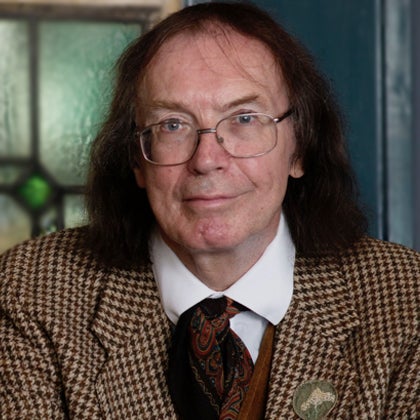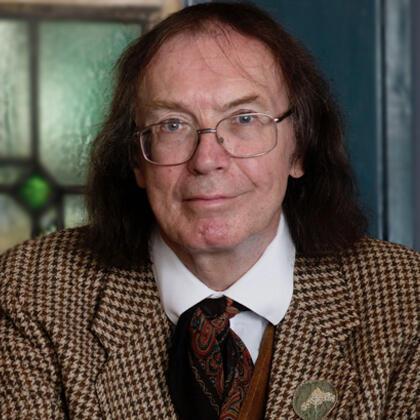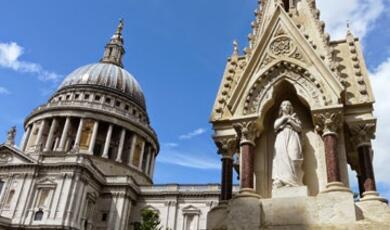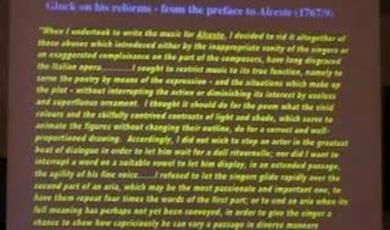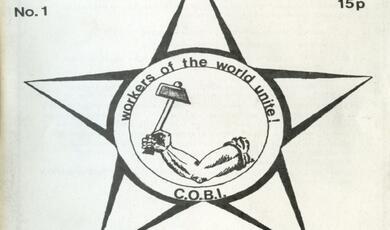Viking Pagan Gods in Britain
Share
- Details
- Text
- Audio
- Downloads
- Extra Reading
The Norse and Danish invaders - commonly called Vikings - who occupied Britain in the ninth and tenth centuries, brought with them their own pagan gods. Odin, Thor, Tyr, Loki and Freya left their trace on the British landscape, in the form of scenes from their mythology carved on stone slabs, and Viking paganism has a further considerable legacy of material evidence in richly furnished graves, especially on the Isle of Man.
Download Text
Viking Pagan Gods in Britain
Professor Ronald Hutton
8th March 2023
The Changing Face of the Vikings
The Debate
The last half a century has seen a transformation in historians’ attitudes to the Vikings. The traditional picture of them was that of plundering psychopaths in helmets and beards who destroyed civilization wherever they found it. From the 1970s Peter Sawyer led the way to a more supportive view, arguing that the Vikings were great civilizers themselves, as explorers, traders, founders of towns and kingdoms, and talented poets and craftspeople. It seems now that both views are true: they arrived as looters and turned into farmers, traders and town-builders.
The Current View
They certainly did all the wonderful things that Sawyer has described, but only when they ceased to be Vikings. The term ‘Viking’ means a Scandinavian raider, not trader or settler, and those were every bit as nasty as the traditional picture made them. They were not driven to attack other peoples by population pressure. They came to plunder when expanding trade networks revealed the riches of Europe further south. They at first especially attacked monasteries, built on sea shores and peninsulas to afford their occupants seclusion and now easy targets to seaborne enemies. The loss of much early Anglo-Saxon literature may be blamed on them.
It is a simple truth that Scandinavian literature which celebrates the Viking age shows an admiration for psychotic violence which is rare in most cultures. For example, there is the story from Egil’s Saga Skallagrimmsonr, of how the ninth-century hero Egil, when six years old, was bullied by another boy at a ball game. Egil’s response was to drive an axe through his brain, killing the bully immediately and delighting Egil’s mother, who predicted a great future for her son. A different example is a poem by Bjorn Cripplehand, court poet of the Norse king Magnus Bareleg’s, about the king’s cruise through the Hebrides in 1098, and the destruction and slaughter that he inflicted on every island. Magnus, it should be noted, ruled at a relatively late period when the Vikings were Christian and regarded as much more civilized.
As heathens, the initial Viking raiders were especially terrible to the Christian societies that they struck, because they despoiled churches and carried off clergy as slaves. They became, in fact, the greatest slave traders of the northern world.
What Is The Evidence for Their Paganism?
The Literary Problem
The great traditional source is medieval Scandinavian literature, especially that from Iceland. This however all dates from 150 to 400 years after the conversion to Christianity. It consists of scholarly works, poetry or sagas, which are long prose tales. Our problem is that medieval Icelandic writers were not only Christian but highly sophisticated. All but forty of the 1600 surviving Icelandic sagas are about foreign subjects, such as the Trojan War, Charlemagne, Biblical characters and Christian saints. The main sources of the scholars and saga-writers for northern paganism were poems which they may no longer have fully understood. Their portraits of it may also have been influenced by the later paganism of the Slav and Baltic peoples against which the Christian Scandinavians launched crusades, with its large, well-built temples. As a result of all this, those portraits seem to be a mixture of old native tradition, Christianity and Graeco-Roman paganism, and it can be very hard to distinguish between those elements.
For example, one of the most famous poems that refers to Viking paganism is from the collection called the Havamal. It portrays the god Odin achieving wisdom by hanging nine days and nights on a tree, stabbed with a spear as a sacrifice to himself. Is this a memory of authentic pagan tradition? Or an assimilation of Odin to Christ? The only clear difference between them is that Odin hangs for nine days and nights before resurrecting.
There are similar problems with other aspects of the literature. It states that there are ten or twelve Norse deities in their mountain home of Asgard, but the actual stories show fewer or more of them. The reason why those numbers are cited as canonical seems to be because the ancient Greeks had twelve major deities dwelling on their mountain of Olympus.
It also complicates things that Norse poets, ‘skalds’, loved puns and word plays. So, if you find a deity mentioned in verse who is found nowhere else, she or he could be a genuinely distinct one or a nickname for Odin, Thor, etc. Goddesses tend to be few and subordinate in the stories, but many and mighty in poetry. Kormak’s Saga has chunks of poetry by the hero, which name six well-known deities, one slightly known one, and ten goddesses who only appear in those chunks.
The literature does contain some definite memories of paganism. Volsunga Saga has two in verses included in the text. One speaks of carving the runes (symbols) of the war god Tyr on a sword: and Viking swords have been found with exactly those runes of them. Another speaks of the lack of a common picture of the life after death, listing different kinds of superhuman being with whom dead humans were thought to take up residence.
Major elements of Norse mythology unfortunately remain doubtful as aspects of earlier pagan tradition. Valhalla, the Viking paradise to which warriors slain in battle were taken, and Ragnarok, the predicted destruction of the pagan gods in a final battle, are two. They only appear in relatively late sources and may be paganized versions of the Christian heaven and apocalypse.
In general, saga heroes, whether pagan or Christian, were rarely very religious. Their general attitude is summed up by the leading character of Finnbogi’s Saga, who on being asked by a Christian emperor on what he believed, replied ‘me’. This made a fit with the stoic, self-reliant attitude of the rootless, adventuring Vikings.
Deities
There are however some clearly distinctive and recurrent deities in the literature. The greatest, and their leader, is Odin, god of travel, wisdom, knowledge, war and poetry. Second in importance is Thor, god of the sky, weather and farming. Next comes Frey, patron of fertility in crops and animals, and Freya, goddess of love, war and magic. Baldur was the most handsome and beloved god, and Tyr the heroic war god who sacrificed his hand to bind the monstrous wolf Fenris. Finally there is the trickster Loki, sometimes merely cunning and devious, and sometimes downright evil. Mortal heroes are also prominent in the tales, especially the dragon-slayer Sigurd.
How Does All This Relate To The British Isles?
The first point to make here is that pagan Viking Britain lasted a very short time. Vikings arrived in it from the 790s, and were all converted to Christianity there by the 990s, and in their Scandinavian homeland by 1030. So we are looking at around two hundred years at most.
In the majority of Britain the period was actually even shorter. In England settlement only really started in the 860s, and the last pagan Viking ruler was removed in 954. So the pagan period is less than a century in southern Britain and less than two centuries in the north. Vikings were, after all, settling among a more numerous and sophisticated Christian population that readily assimilated them. All in all, this was the paganism that made the slightest impression on Britain.
What is the Evidence for British Viking Paganism?
The Literary Sources
The first category of these consists of place names. Only those of Orkney have been properly studied, and they have lots derived from Odin and none from Thor. The opposite is true of Iceland, perhaps because the settlers there were mostly farmers, who venerated Thor, while most of those in Orkney were warriors and traders, who worshipped Odin. The second category consists of Christian chronicles and Icelandic sagas. These have very little relevant to Britain but do agree that Viking armies carried raven banners, probably sacred to Odin. The third category consists of law codes, issued in the early eleventh century by King Canute and Archbishop Wulfstan to wipe out pagan practices among Viking settlers in England. They prohibit the veneration of trees, pools and stones, and of the sun and the moon, and the use of pagan songs and charms. This looks like a family-based religion which used natural landmarks: there is no mention of temples or priests.
One especially famous and lurid alleged pagan rite found in literature is that of the Blood Eagle, in which an enemy leader was said to be killed by having his ribs cut from his spine and spread in the form of an eagle’s wings. It appears in four stories from the twelfth to the fourteenth centuries. Two are legends, and two are bits of alleged ninth-century history. In 1984 Roberta Frank pointed out that all of them actually derive from one original, in the late twelfth-century Orkneyinga Saga, concerning the Orkney earl Torf-Einar. The saga version in turn depends on a skaldic poem, in which Torf-Einar boasts of his enemy being ‘torn by the eagle’s talon’ before burial. It may just mean that his corpse was eaten by carrion birds.
The Archaeological Evidence: (1) Deposits and Carvings
Archaeology is now the main source of evidence for British Viking paganism, and can be especially useful if combined with overseas material and literary texts. No temples or shrines have been found anywhere. The one apparent ritual foundation deposit is that of animal bones and tools found under a jetty or bridge end at Skene on the River Humber. Thirty-four Viking swords have been found in English rivers, which were probably offerings rather than accidental losses as they are always found by themselves.
There are also carvings on crosses, in churches or churchyards. Many are in the Isle of Man, and many more in northern England. By definition they were made by Christians, but they sometimes have apparent pagan images. The images concerned could indeed suit both religions. The dragon was a symbol of evil in both. Loki could be equated with Satan and Ragnarok with the Christian apocalypse. Heroes are more common than deities in the carvings, especially Sigurd the dragon-slayer, who could match the Archangel Michael. There is some mythology on them. Tyr and the wolf Fenris appear on a slab in a church at Sockburn, County Durham. Gods feature occasionally, so that on the scores of Manx crosses, Odin appears twice and Thor once. The Vikings had no tradition of carved stone scenes before the conversion period, so these must have been made for the crosses. They could have represented an assimilation of paganism to Christianity, or a sign of the two religions existing side by side for a time.
The Archaeological Evidence: (2) Burials
Burials now represent the greatest single source of information for pagan Viking Britain. Across the island, most are of warrior leaders- high-status males with weapons. Carvings on cross slabs show men lying in graves with swords, and swords are indeed sometimes found in northern English churchyards. Such graves are common in Norse-settled areas of Scotland- the far north and the islands. The men have weapons, the women jewellery, and both have horses and dogs. At Sanday, Orkney, in 1992, a ‘family vault’ was found, of a child, woman and man lying in a wooden burial chamber constructed inside a twenty-foot boat. They had a cross-section of ninth-century personal goods, including a sword, a quiver of arrows, a comb, a sickle and a brooch, and even an ironing board.
The most awe-inspiring Viking deposits in Britain are those excavated over the past fifty years at Repton, on the river Trent in Derbyshire, the base of an invading Viking army in the early 870s, led by the sons of the legendary hero Ragnar Lothbrok. They included a huge dump of bones around an elite burial which mixed the bodies of Vikings with those of long-dead monks from the Anglo-Saxon monastery on the site. Did the Vikings want to give their dead extra sanctity by associating them with native holy men, or were the monks’ skeletons dug up to mock and defile them, or even represent human sacrifices? The church on the site, of St Wystan, had been the mausoleum of the rulers of the local Anglo-Saxon kingdom, of Mercia. Did the Vikings camp around it to identify with those native kings, and claim the land as their heirs, or were they desecrating the site to destroy native English authority? We cannot tell. There were also some individual burials in the churchyard, of which one was that of an absolutely classic pagan Viking. He had been killed by a sword slash that had opened the artery in his thigh. He had a silver Thor’s hammer amulet, a sword, a knife, a key (perhaps to his strong box), and a boar tusk and a jackdaw’s bone (both perhaps more amulets). But what was he doing in a Christian churchyard? These questions are complicated further by the discovery at Henley Wood, nearby, of a cemetery of around sixty mounds, left by other members of the army at Repton, or by settlers who followed them. Bodies of both sexes were cremated on wooden platforms with food (beef, mutton and pork), domestic animals (horses and dogs) and swords and belts. Mounds were then raised over them. Were these the resting places of invaders who identified as obdurate heathens, while those who related better to Christianity chose to be buried beside the church at Repton? We just do not know.
The British capital of Viking archaeology is, however, the Isle of Man, which remains an independent lordship of the Crown. It has the greatest collection of Scandinavian carved stones outside Scandinavia, and forty burials with goods. In Jurby parish, six of the eight farms had a great burial mound on their land, probably that of the original Viking settler to take it.
Some of the Manx burials are especially interesting. At Balladoole a ship burial was put into an existing Christian cemetery; and this time the intrusion seems to have been a deliberate act of desecration and obliteration as it dug straight through existing graves. Into the ship was put a man, with a severed head, apparently female, placed next to him. They were overlaid by the burned bones of horse, ox, sheep or goat, pig, dog and cat. This may therefore have been a scene of human and animal sacrifice, but the woman and the animals may have been companions, the woman killed in a raid alongside the man. A big post had stood at the end of the ship, perhaps a ship mast or figurehead, or totem pole.
At Knock-y-Doonee a man was buried in the prow of a boat, wrapped in a cloak with a knife, sword, axe, spear, shield and an iron bowl covered in a cloth. A smith’s hammer and a fishing net were left in the stern, perhaps emblems of his occupations in life. A horse and probably a dog were laid in the middle of the boat.
At Cronk Mooar a planked burial chamber was built in a pit, and contained a man in a cloak and belt. A knife was stuck in the belt and a sword laid beside him. The body had maggots in it before burial, so either he had lain in state for a long time before being interred, or had died elsewhere and been brought home to Man.
The most ghoulish site of all is Ballateare. There a young man had been put in a coffin surrounded by a shattered sword and shield, plus three spears and a knife. Laid over the coffin was the body of a young woman, who had been killed by a great blow from a sword or an axe which had sheared off the back of her skull. Over them was piled a layer of burnt bones of dog, sheep, ox and horse. Then a mound was built over the lot. Was the woman a sacrifice, like the animals, to accompany the warrior? A famous account by the Arab traveller Ibn Fadlan of people who may have been Vikings, on the Volga river in Russia, describes how a slave girl was sacrificed at the funeral of a chief there. That may be a parallel. On the other hand, as at Balladoole, both woman and man may have been a couple who died together in the same violent incident.
Once more, we are left not with certainties but with questions and choices. The latter hark back, like so much, to the dual aspect of the Vikings, as barbarous destroyers or courageous explorers and creators. Whether you yourselves choose one of those, or neither, is up to you, and the glorious thing about posing so many unresolved questions is that this does leave you with the freedom to choose.
© Professor Hutton 2023
References and Further Reading
Graham Campbell, James, and Colleen E. Batley. Vikings in Scotland. 1998.
Graham-Campbell, James, et al, eds. Vikings and the Danelaw. 2001.
Hadley, D. M. The Vikings in England. 2006.
Wilson, David M. The Vikings in the Isle of Man. 2008.
References and Further Reading
Graham Campbell, James, and Colleen E. Batley. Vikings in Scotland. 1998.
Graham-Campbell, James, et al, eds. Vikings and the Danelaw. 2001.
Hadley, D. M. The Vikings in England. 2006.
Wilson, David M. The Vikings in the Isle of Man. 2008.
Part of:
This event was on Wed, 08 Mar 2023
Support Gresham
Gresham College has offered an outstanding education to the public free of charge for over 400 years. Today, Gresham College plays an important role in fostering a love of learning and a greater understanding of ourselves and the world around us. Your donation will help to widen our reach and to broaden our audience, allowing more people to benefit from a high-quality education from some of the brightest minds.


 Login
Login
